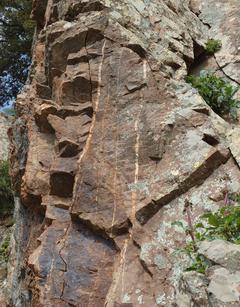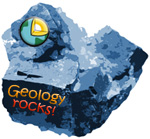The coastal avenue here cuts across a hill called Punta Gorda, which gives the name to the area. On this hill there is a frequently visited square and park called Plaza de la Armada, where we see the Monumento a los Caídos en el Mar, a sculpture of surrealist art dedicated to the fallen during service to the Navy.
Walk behind this sculpture, to the right towards the beach. Here you will find the earthcache.
La avenida costera ataca aquí una colina llamada Punta Gorda, que da el nombre al área. En esta colina hay una plaza muy frecuentada y un parque llamado Plaza de la Armada, donde vemos el Monumento a los Caídos en el Mar, una escultura de arte surrealista dedicada a los caídos durante el servicio a la Armada.
Camina detrás de esta escultura hacia la playa. Aquí encontrarás el Caché Tierra.
QUARTZ
Quartz is the second most abundant mineral in the Earth's continental crust, after feldspar. It is made up of a continuous framework of SiO4 silicon–oxygen tetrahedra, with each oxygen being shared between two tetrahedra, giving an overall formula SiO2.
There are many different varieties of quartz, several of which are semi-precious gemstones. Especially in Europe and the Middle East, varieties of quartz have been the most commonly used minerals in the making of jewelry since antiquity.

El cuarzo es el segundo mineral más abundante en la corteza continental de la Tierra, después de feldespato. Se compone de un marco continuo de SiO4 tetraedros de silicio-oxígeno, cada uno con oxígeno que se comparte entre dos tetraedros, dando una fórmula general SiO2.
Hay muchas variedades diferentes de cuarzo, varias de las cuales son piedras semi-preciosas. Especialmente en Europa y el Medio Oriente, las variedades de cuarzo han sido desde la antigüedad los minerales más utilizados en la fabricación de joyas.
QUARTZ VEINS
Quartz is often found in veins that cut through rocks. Although the term "vein" suggests this, the veins of quartz and other minerals are usually not thin tubes, but rather thin sheets. The veins can form under various conditions, and depending on these conditions, may or may not bear quartz crystals in them.
Even though certain types of quartz veins do never bear any quartz crystals, it sometimes makes sense to follow large quartz veins to look for crystal-bearing fissures: Should a rock that contains old large quartz veins have been folded later due to tectonic forces, the quartz veins represented a disturbance (a discontinuity in the otherwise homogeneous mechanical properties), and alpine-type fissures are likely to open up between the quartz and the host rock.
The simplest type of a quartz vein is the filling of an already present crack in rocks. The crack might form during folding of the rock in mountain-building processes, by shattering during tectonic events, by a decrease in pressure during the uplift of a rock, or because a rock cools down and shrinks. Hot brines that percolate the rocks and originate at greater depths with higher temperatures will precipitate the minerals they carry with them in cracks at lower temperatures and pressures. This process may continue until the crack is completely filled or may stop before, leaving "pockets" in the vein that are sometimes outlined by crystals. Hot brines that enter a crack in the rock from some distant hot source like a granite pluton first cool and precipitate most of their load rather quickly. The result is milky quartz, either massive or made of interlocked milky quartz crystals. Later, when the crystal growth slows down, the crystals may get less milky or even clear. In the majority quartz veins, most of the quartz is precipitated as massive, milky quartz, and well-formed crystals, if found at all, are only a small portion of the vein filling.

Cuarzo se encuentra a menudo en las venas que atraviesan rocas. Aunque el término "vena" sugiere esto, las venas de cuarzo y otros minerales por lo general no son tubos delgados, sino más bien hojas delgadas. Las venas pueden formar en diversas condiciones, y en función de estas condiciones, pueden o no pueden soportar los cristales de cuarzo en ellos.
A pesar de que ciertos tipos de venas de cuarzo nunca tienen ningún cristales de cuarzo, a veces tiene sentido seguir grandes venas de cuarzo para buscar fisuras cristal que soportan: En caso de una roca que contiene viejas e grandes venas de cuarzo que se han doblado más tarde debido a fuerzas tectónicas, la venas de cuarzo representados una perturbación (una discontinuidad en las propiedades mecánicas homogéneas de otro modo), y fisuras de tipo alpino son probable que se abra entre el cuarzo y la roca huésped.
El tipo más simple de una vena de cuarzo es el llenado de una grieta ya presente en las rocas. La grieta podría formar durante el plegado de la roca en los procesos de construcción de montaña, por rotura durante los eventos tectónicos, por una disminución de la presión durante el levantamiento de una roca, o porque una roca se enfría y se contrae. Salmueras calientes que se filtran a las rocas y se originan a mayor profundidad con temperaturas más altas se precipitarán los minerales que llevan con ellos en las grietas a temperaturas y presiones más bajas. Este proceso puede continuar hasta que la grieta se llena por completo o se puede detener antes, dejando "bolsillos" en la línea que a veces se describe por los cristales. Salmueras calientes que entran en una grieta en la roca de una fuente caliente distante como un plutón granítico primero fresco y precipitan la mayor parte de su carga con bastante rapidez. El resultado es el cuarzo lechoso, ya sea masiva o hechos de cristales de cuarzo lechoso entrelazados. Más tarde, cuando el crecimiento de los cristales se ralentiza, los cristales pueden recibir menos lechosa o incluso clara. En las venas de cuarzo de la mayoría, la mayor parte del cuarzo se precipita en forma masiva, cuarzo lechoso, y cristales bien formados, si se encuentra en todo, son sólo una pequeña parte del relleno de la vena.
THE EARTHCACHE
The Earthcache takes you to a granite outcrop, where you can observe several quartz veins.
In order to log this Earthcache as a find you have to search in the granite outcrop and send a e- mail or message via our profile with the following:
- What is the simplest way of a quartz vein to be formed?
- What is the thickness of the quartz veins?
- At what angles do some of these veins meet?
Photos in the log are always welcome, but please do not post photos that show the answers of the Earthcache! Thank you.
After sending the answers by e-mail you can log the Earthcache. You will be contacted to cornfirm or clarify your answers.
El Caché Tierra le lleva a un afloramiento de granito, donde se pueden observar varias venas de cuarzo.
Con el fin de hacer que el encontrado de esta Earthcache tiene que buscar en el afloramiento de granito y enviar un correo electrónico a través de nuestro perfil con el siguiente:
- Cuál es la forma más simple de una veta de cuarzo formarse?
- Cuál es el espesor de las venas de cuarzo?
- Cuál es el grado de la apertura de los ángulos más pequeños formados?
Fotos en el registro son siempre bienvenidos, pero por favor no publicar fotos que muestran las respuestas de Earthache! Gracias.
Después de enviar las respuestas por correo electrónico puede registrar el Earthcache. Si hay alguna duda con respecto a las respuestas usted será contactado para clarificarla.
WELL DONE to "__gentleyak________" on the 'FTF'

